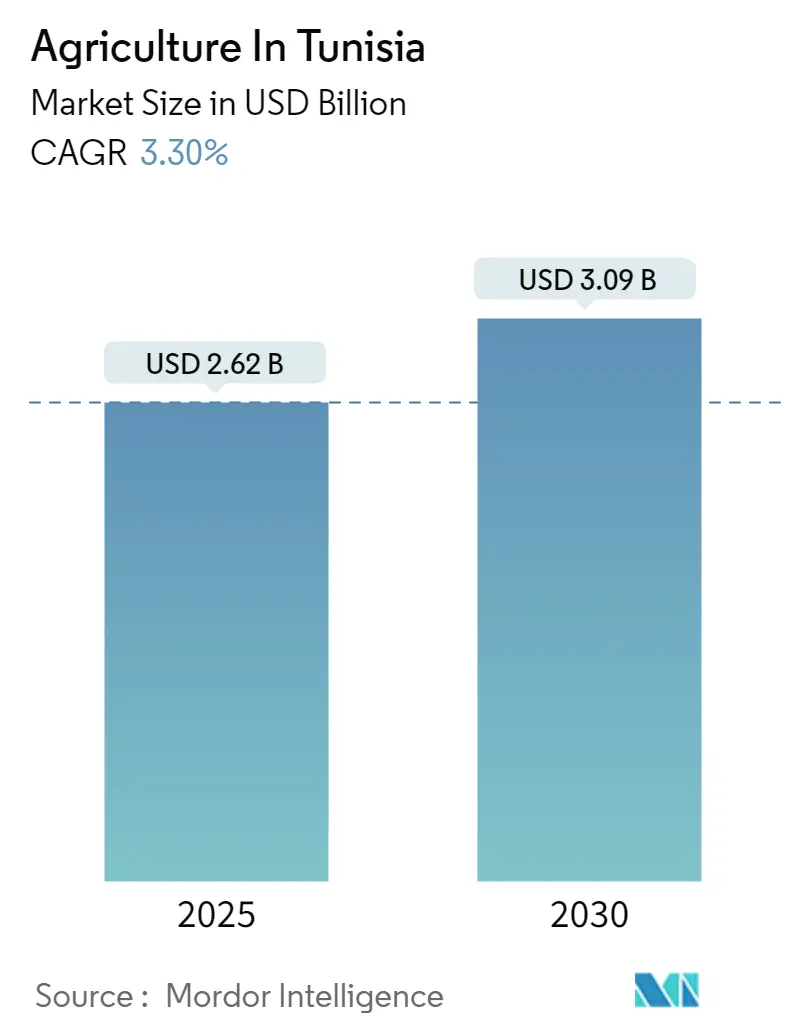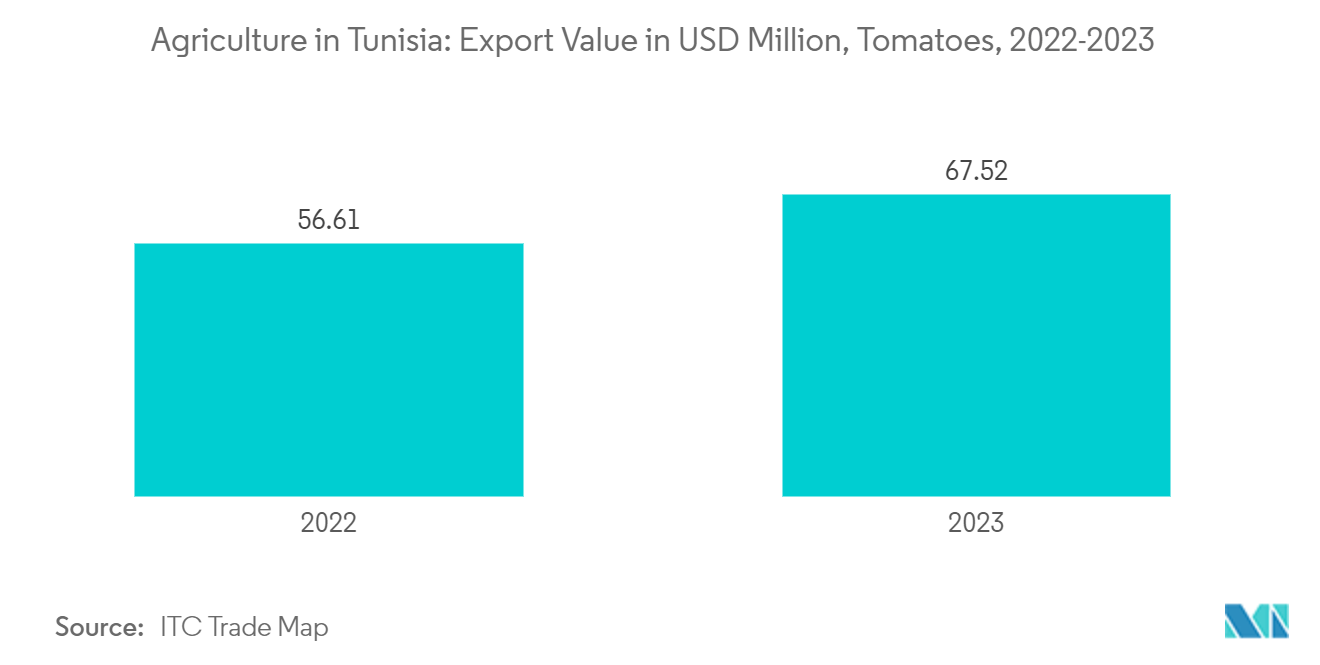
| Study Period | 2019 - 2030 |
| Base Year For Estimation | 2024 |
| Forecast Data Period | 2025 - 2030 |
| Historical Data Period | 2019 - 2023 |
| Market Size (2025) | USD 2.62 Billion |
| Market Size (2030) | USD 3.09 Billion |
| CAGR (2025 - 2030) | 3.30 % |
Agriculture In Tunisia Market Analysis
The Agriculture In Tunisia Market size is estimated at USD 2.62 billion in 2025, and is expected to reach USD 3.09 billion by 2030, at a CAGR of 3.3% during the forecast period (2025-2030).
Agriculture is a vital economic sector in Tunisia, playing a crucial role in ensuring food security and providing employment to the workforce. As of 2023, the sector contributed 9.47% to the country's GDP, according to the World Bank. Key crops grown in Tunisia include olives, wheat, barley, tomatoes, almonds, dates, broad beans, and apples. Olive oil stands out as the most significant agricultural product due to its high export value. Tunisia ranks among the world's largest olive producers, with a production volume of approximately 1.2 million metric tons in 2022, according to data from the Food and Agriculture Organization (FAO).
The country's strategic location near Europe heavily influences its agricultural exports, with the majority directed toward European markets. This proximity has driven a surge in organic farming in Tunisia, catering to Europe's rising demand for organic products. Tunisia is the largest organic olive oil exporter to the European region, it exported about 55,717 tonnes, including 45,000 tonnes of organic olive oil as of 2022, according to an article published by the European Journal of Agriculture and Food Sciences.
Despite its strong agricultural foundation, Tunisia remains a net importer of certain products, particularly cereals and vegetables, due to limited domestic production. To address this, the Tunisian government, along with various global organizations, has implemented measures to boost agricultural output. For instance, in May 2023, the Supporting Sustainable Agriculture and Fisheries in Tunisia initiative was launched by Tunisia’s Agri Ministry. This is a European-funded program, implemented by the Italian Development Cooperation Agency and the World Food Programme, which is designed to assist small-scale producers in Tunisia. The program aims to address rising production costs and help farmers adapt to the challenges posed by climate change. These efforts aim to enhance food security and diversify the nation's economy.
Agriculture In Tunisia Market Trends
Growing Preference For Organic Farming
Tunisia has become a significant player in organic agriculture within Africa, despite its relatively small size. According to the Research Institute of Organic Agriculture (FIBL), Tunisia had 227,581 hectares under organic cultivation in 2022, compared to Algeria's 1,071 hectares in the same year. This growth is supported by government policies promoting organic farming. The Technical Centre of Organic Agriculture (CTAB) provides technical assistance and training to farmers on organic production methods. The expansion of organic agriculture in Tunisia is driven by increasing European market demand for organic products and growing awareness of sustainable agricultural practices.
Olive and date cultivation dominate Tunisia's organic agricultural landscape. According to a report by the European Journal of Agriculture and Food Sciences (EJFOOD), in 2022, organic olive farming accounted for about 93% of the total organic-certified area, highlighting the country's specialization in this sector. Tunisia has also experienced an increase in organic date cultivation, which grew by about 4% between 2019 and 2022, according to FiBL statistics, indicating diversification within the organic farming sector.
Tunisia has established a robust certification system to maintain the integrity of its organic products and ensure compliance with international standards. As organic farmland expands and regional organic export demand increases, Tunisia's agriculture sector is projected to continue growing during the forecast period, potentially creating new markets and opportunities for Tunisian farmers.
To meet the rising demand for organic certification and enhance their competitiveness in the global market, many Tunisian farmers are obtaining certifications from reputable organizations such as International Master Control (IMC), European Certification of Organic Agriculture (ECOCERT), and British Standards Institution Certification (BCS). These certifications assure consumers and international markets that the products meet organic standards while helping Tunisian farmers access premium markets and potentially command higher prices for their produce.
High Export Potential of Agricultural Products
Tunisia has established itself as a significant exporter of agricultural goods to neighboring countries and European markets. Key exports include tomatoes, olive oil, potatoes, lettuce, and dates. Trade agreements with European Union nations, enabling tax-free trade, have boosted the country's agricultural exports. As a result, Tunisia has experienced a steady increase in agricultural exports in recent years. According to the ITC Trade Map, Tunisia's tomato exports increased by over 88.7% from 2019 to 2023, reaching a value of over USD 67.5 million in 2023.
The Tunisian government is actively promoting its agricultural products globally through several initiatives. One such effort is the PAMPAT 2 (Project for Market Access of Typical Agrofood Products), launched in January 2020. This project focuses on enhancing the visibility and marketability of local food products, including prickly pear, dried tomatoes, processed dates, and pomegranates. These efforts have yielded significant results, with nearly 90% of the dried tomatoes produced in Tunisia now exported globally. This outcome reflects strong government support and high export demand. The strategic focus on enhancing export capabilities and market access is positioning Tunisia as a key player in regional and global agricultural markets.

Agriculture In Tunisia Market News
- May 2023: The Tunisian Ministry of Agriculture has launched the Supporting Sustainable Agriculture and Fisheries in Tunisia (ADAPT) initiative. Funded by the European Union and implemented by the Italian Development Cooperation Agency in partnership with the World Food Programme, this program is designed to support small-scale producers in Tunisia.
- June 2022: The World Bank approved a loan of USD 130 million to Tunisia, aimed at financing cereal imports to stabilize the country's food security. The loan also includes procuring over 40,000 metric tons of quality wheat seeds to provide farmers in the planting season, which helps grow cereal production in the country.
Agriculture In Tunisia Industry Segmentation
Agriculture is the practice of cultivating plants and crops such as cereals, fruits, vegetables, flowers, pulses, etc., for both human and animal consumption and other uses. The Agriculture Market in Tunisia is Segmented by Type into Food Crops/Cereal, Fruits, Vegetables, and Oilseeds/Non-food Crops. The report also offers Production Analysis, Consumption Analysis (Volume and Value), Import Analysis (Volume and Value), Export Analysis (Volume and Value), and Price Trend Analysis in the country. The report offers market size and forecast in terms of value in USD and volume in metric tons for the above-mentioned segments.
| Crop type | Food Crops/Cereals | Production Analysis | |
| Consumption Analysis (Volume and Value) | |||
| Import Market Analysis (Volume and Value) | |||
| Export Market Analysis (Volume and Value) | |||
| Price Trend Analysis | |||
| Fruits | Production Analysis | ||
| Consumption Analysis (Volume and Value) | |||
| Import Market Analysis (Volume and Value) | |||
| Export Market Analysis (Volume and Value) | |||
| Price Trend Analysis | |||
| Vegetables | Production Analysis | ||
| Consumption Analysis (Volume and Value) | |||
| Import Market Analysis (Volume and Value) | |||
| Export Market Analysis (Volume and Value) | |||
| Price Trend Analysis | |||
| Oilseeds/Non-food crops | Production Analysis | ||
| Consumption Analysis (Volume and Value) | |||
| Import Market Analysis (Volume and Value) | |||
| Export Market Analysis (Volume and Value) | |||
| Price Trend Analysis | |||
Agriculture In Tunisia Market Research FAQs
How big is the Agriculture In Tunisia Market?
The Agriculture In Tunisia Market size is expected to reach USD 2.62 billion in 2025 and grow at a CAGR of 3.30% to reach USD 3.09 billion by 2030.
What is the current Agriculture In Tunisia Market size?
In 2025, the Agriculture In Tunisia Market size is expected to reach USD 2.62 billion.
What years does this Agriculture In Tunisia Market cover, and what was the market size in 2024?
In 2024, the Agriculture In Tunisia Market size was estimated at USD 2.53 billion. The report covers the Agriculture In Tunisia Market historical market size for years: 2019, 2020, 2021, 2022, 2023 and 2024. The report also forecasts the Agriculture In Tunisia Market size for years: 2025, 2026, 2027, 2028, 2029 and 2030.
Our Best Selling Reports
Agriculture In Tunisia Industry Report
Statistics for the 2025 Agriculture In Tunisia market share, size and revenue growth rate, created by Mordor Intelligence™ Industry Reports. Agriculture In Tunisia analysis includes a market forecast outlook for 2025 to 2030 and historical overview. Get a sample of this industry analysis as a free report PDF download.





